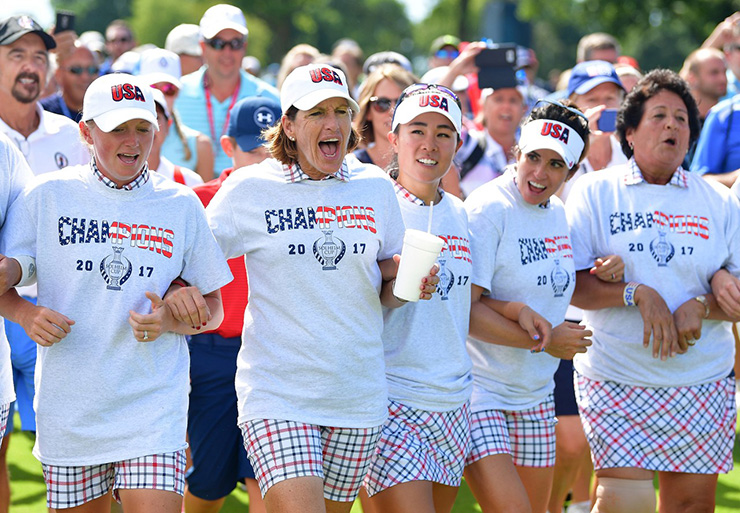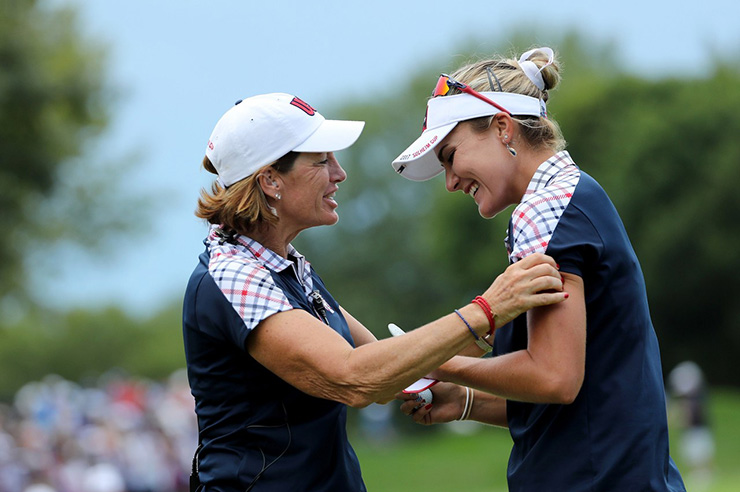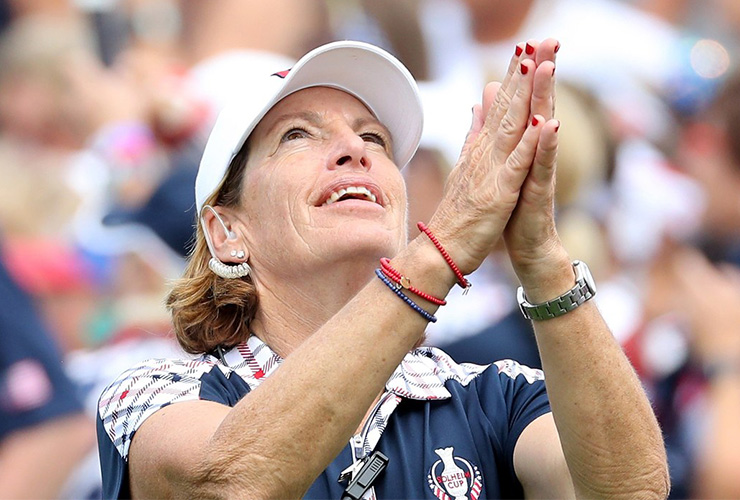How Juli Inkster became the embodiment of the Solheim Cup—and made the matches fun again
By Keely Levins
As the fifth singles match came through the difficult par-3 17th hole at Des Moines Golf & Country Club on Sunday, the Solheim Cup about to be decided, the numbers were being crunched.
If Angel Yin won, the Americans would have earned 3½ points for the day, enough to secure a tie and retain the prize they had been so desperately pursing in front of the raucous crowds. When she made bogey, and Europe’s Karine Icher made par, the match went on to the 18th all square.
Yin ended up halving her match, so now the focus turned to Lizette Salas, facing Jodi Ewart-Shadoff. Salas was 2 up going into the 17th, so the worst that could come of her match would be a half. That meant the U.S. had its 3½ points, enough to clinch the Cup.
With that knowledge, U.S. captain Juli Inkster, who had been walking back and forth through a patch of rough between the 17th green and 16th fairway, finally appeared at ease. Forget the large five-point lead her team had going into Sunday singles. Inkster was nervous on Sunday. The 57-year-old had seen pretty much everything in her four-plus decades of competitive golf, including her own team come back from a four-point deficit two years ago in Germany, the biggest rally in Solheim Cup history. She wasn’t counting out Europe until it was over.
“How could you not be nervous? The problem is, 18 holes is a lot of golf,” said Inkster. “You’re just watching the board. I felt like I had no control over anything. Once I got out on the golf course and got to talk to the girls, I felt a lot better.”
It was a big moment, but one that Inkster chose to reflect on at first internally. Eventually, assistant captains came over to hug her, as did European captain Annika Sorenstam. And Inkster was all smiles, hearing through radios that Salas was going to get the outright win on the 18th and hopping in a cart to get down there in time to watch.
“It was my job to bring fun back to the Solheim Cup.” —Juli Inkster
The captain walked up to the green as Salas lined up her par putt. It fell, and soon an American flag was across the young woman’s shoulders, Inkster was on the green hugging her, more teammates and assistant captains rushed to be part of the celebration. The crowd continued its chant of “USA-USA-USA.”
There would be no historic European comeback. When the final matches wrapped up, the Americans won 16½-11½, taking the Cup for a second straight year and the 10th time in 17 matches. But there was some history made; it turned out being the largest margin of victory for the U.S. team since they won 17-11 in 1996.
• • •
The Solheim Cup is an odd mix of individual performances and intense teamwork. It’s a week where 12 athletes from the U.S. and 12 from Europe, who almost every other week of the year compete for themselves are suddenly in a situation where they’re competing for their teammates, for their captains and for their countries.
It’s something the captains have to balance, too.
Like the best leaders in any sport, Inkster provided a huge support system for her squad. A number of her players were only junior golfers when Inkster was dominating the LPGA, winning 31 tour events, including seven majors, and earning a place in the World Golf Hall of Fame. The generational divide allowed for her players to hold a true admiration and respect towards Inkster, even as she could be seen pumping up the crowd—who can’t get enough of her—and dancing around the first tee.

Inkster leads her U.S. team’s celebration during the final day singles matches of the 2017 Solheim Cup. (Photo by Stuart Franklin)
For all the ways that Inkster worked well with others, however, she also admitted to the Golf Channel, “I don’t like a lot of people around me. I like to be by myself.”
It’s this ability to function as an individual within the framework of a team that made Inkster a great captain. And by being a great captain, Inkster helped personifies what Solheim Cup means to so many involved in it, players, officials and fans alike.
“She’s a legend,” Brittany Lincicome said of Inkster. “It’s an honor to play for her. And she keeps telling us do it for yourselves, not for me. But it’s kind of hard not to do it for her because she’s just so fantastic.”
As impressive as Inkster is as an individual, what made her so vital to this team’s success was her true understanding of how a team should function. Inkster’s players trusted her, even if they don’t completely understand how she was able to bring out the best in their play. All they know is, unlike almost every other week of the year, the three-days in Iowa saw more of them making more long putts than anybody could remember.
“She’s intense on the golf course,” Stacy Lewis said. “And she’s passionate. And she wants to win more than anybody. And that’s what she brought out in all of us on that Sunday [in 2015]…. I don’t know what she did but she brought it on all of us.”
“Juli said something that really hit home for me,” said Cristie Kerr, the oldest player on the U.S. team at 39 and thus the one that has the closest connection to her in Inkster’s truly competitive days. “You play for the person in front of you, you play for the person behind you. It’s not about your individual records. It’s for the team. It’s amazing you can pull for each other when you have that mentality.”
• • •
There are many examples of Inkster picking her team members up, but none demonstrates that ability better than with Lexi Thompson in her opening Sunday singles match against Anna Nordqvist. Both golfers were expected to set the tone for the day for their respective teams. With Thompson being the No. 2 player in the world, Nordqvist battling mono, and the Americans riding their seeming insurmountable five-point lead, it seemed likely that the tone of the match would mimic the “USA-USA-USA” chants ringing through the course.
But Nordqvist won the first four holes, and Thompson didn’t look like herself. She was missing fairways and short putts. Inkster, who had been on the first tee, came out to talk to her after the fourth hole.
Thompson made the turn still 4 down. But then, something happened. She won the 10th with a birdie. She then holed out from the fairway on the 11th for an eagle. She stuck her approach to a foot and a half on 13. She dropped a 30-footer for another eagle on 15 to bring it to all square, and then added another birdie for good measure on the 16th The two halved the 17th with bogeys, and the match went down the 18th. A few hours earlier, no one could have imagined it would get that far. It ended all square, each player winning half a point.

Inkster embraces Lexi Thompson on the 18th green after Thompson rallied to halve the first singles match against Anna Nordqvist during Sunday play at the 2017 Solheim Cup. (Photo by David Cannon)
“I just told her, ‘Hey, you know, you’re the best player on this team. And you got a ton of holes left.’ I said, ‘You just gotta keep plugging away,’ ” said Inkster.
“That’s all I needed to hear,” Thompson said of the exchange.
Of course, you can’t give complete credit to a captain for the success of the team’s play. Ultimately, the players have to show up and win points. They deserve the real accolades. And Inkster wouldn’t want it any other way.
“I’ve been fortunate to play in a lot of Solheim Cup teams,” she said, having won as a player five times. “I just felt the last couple times I wasn’t having any fun. It was a chore. I just felt like everybody was going in different directions and even though we were a team, were we a team?”
In her first few Solheim Cups, Inkster said the team spend more time together and were able to bond through that. “I just felt like we were losing that,” said Inkster.
“It was my job to bring fun back to the Solheim Cup. And whether we win or lose, you know what? It doesn’t matter. It’s the memories you create. It’s the bonding you create. It’s the atmosphere you create.”
With the win, Inkster becomes the second U.S. captain to win two in a row. Sitting in the press room with a dozen players smiling and laughing, Inkster in the middle cracking jokes, it’s hard to imagine the Solheim Cup without her. So, it was natural to ask if she’d be interested in captaining a third time.
“I don’t want to go there,” said Inkster. “I would love to do it, but I think there are other people in line who want a chance. But I’ll be there. I’ll be there with some hugs.”
The truth is, no one can really picture a Solheim Cup without her.









